Analysis of Microstructure and Mechanical Properties of Bi-Modal Nanoparticle-Reinforced Cu-Matrix
Abstract
1. Introduction
2. Materials and Methods
2.1. Materials
2.2. Spark Plasma Sintering (SPS)
2.3. Mechanical Properties
3. Results
3.1. XRD Analysis
3.2. Densification
3.3. Microstructure Analysis
3.4. Mechanical Strength
3.5. Strengthening Criteria
4. Conclusions
Author Contributions
Funding
Institutional Review Board Statement
Informed Consent Statement
Data Availability Statement
Acknowledgments
Conflicts of Interest
References
- Daghigh, R.; Oramipoor, H.; Shahidian, R. Improving the Performance and Economic Analysis of Photovoltaic Panel Using Copper Tubular-Rectangular Ducted Heat Exchanger. Renew. Energy 2020, 156, 1076–1088. [Google Scholar] [CrossRef]
- Abyzov, A.M.; Kidalov, S.V.; Shakhov, F.M. High Thermal Conductivity Composite of Diamond Particles with Tungsten Coating in a Copper Matrix for Heat Sink Application. Appl. Therm. Eng. 2012, 48, 72–80. [Google Scholar] [CrossRef]
- Xiao, Y.; Yao, P.; Zhou, H.; Zhang, Z.; Gong, T.; Zhao, L.; Deng, M. Investigation on Speed-Load Sensitivity to Tribological Properties of Copper Metal Matrix Composites for Braking Application. Metals 2020, 10, 889. [Google Scholar] [CrossRef]
- Cao, G.; Konishi, H.; Li, X. Mechanical Properties and Microstructure of Mg/SiC Nanocomposites Fabricated by Ultrasonic Cavitation Based Nanomanufacturing. J. Manuf. Sci. Eng. Trans. ASME 2008, 130, 0311051–0311056. [Google Scholar] [CrossRef]
- Kaftelen, H.; Ünlü, N.; Göller, G.; Lütfi Öveolu, M.; Henein, H. Comparative Processing-Structure-Property Studies of Al-Cu Matrix Composites Reinforced with TiC Particulates. Compos. Part A Appl. Sci. Manuf. 2011, 42, 812–824. [Google Scholar] [CrossRef]
- Morris, D.G. The Origins of Strengthening in Nanostructured Metals and Alloys. Rev. Metal. 2010, 46, 173–186. [Google Scholar] [CrossRef]
- Sadoun, A.M.; Mohammed, M.M.; Fathy, A.; El-Kady, O.A. Effect of Al2O3 Addition on Hardness and Wear Behavior of Cu-Al2O3 Electro-Less Coated Ag Nanocomposite. J. Mater. Res. Technol. 2020, 9, 5024–5033. [Google Scholar] [CrossRef]
- Zhang, Z.; Chen, D.L. Contribution of Orowan Strengthening Effect in Particulate-Reinforced Metal Matrix Nanocomposites. Mater. Sci. Eng. A 2008, 483–484, 148–152. [Google Scholar] [CrossRef]
- Chandrakanth, R.G.; Rajkumar, K.; Aravindan, S. Fabrication of Copper-TiC-Graphite Hybrid Metal Matrix Composites through Microwave Processing. Int. J. Adv. Manuf. Technol. 2010, 48, 645–653. [Google Scholar] [CrossRef]
- Fathy, A.; El-Kady, O. Thermal Expansion and Thermal Conductivity Characteristics of Cu-Al2O3 Nanocomposites. Mater. Des. 2013, 46, 355–359. [Google Scholar] [CrossRef]
- Elsayed, A.; Li, W.; El Kady, O.A.; Daoush, W.M.; Olevsky, E.A.; German, R.M. Experimental Investigations on the Synthesis of W-Cu Nanocomposite through Spark Plasma Sintering. J. Alloys Compd. 2015, 639, 373–380. [Google Scholar] [CrossRef]
- Shyu, R.F.; Ho, C.T. In Situ Reacted Titanium Carbide-Reinforced Aluminum Alloys Composite. J. Mater. Process. Technol. 2006, 171, 411–416. [Google Scholar] [CrossRef]
- Ni, J.; Li, J.; Luo, W.; Han, Q.; Yin, Y.; Jia, Z.; Huang, B.; Hu, C.; Xu, Z. Microstructure and Properties of In-Situ TiC Reinforced Copper Nanocomposites Fabricated via Long-Term Ball Milling and Hot Pressing. J. Alloys Compd. 2018, 755, 24–28. [Google Scholar] [CrossRef]
- Wang, F.; Li, Y.; Wang, X.; Koizumi, Y.; Kenta, Y.; Chiba, A. In-Situ Fabrication and Characterization of Ultrafine Structured Cu-TiC Composites with High Strength and High Conductivity by Mechanical Milling. J. Alloys Compd. 2016, 657, 122–132. [Google Scholar] [CrossRef]
- Zhao, Q.; Gan, X.; Zhou, K. Enhanced Properties of Carbon Nanotube-Graphite Hybrid-Reinforced Cu Matrix Composites via Optimization of the Preparation Technology and Interface Structure. Powder Technol. 2019, 355, 408–416. [Google Scholar] [CrossRef]
- Akbarpour, M.R.; Mousa Mirabad, H.; Khalili Azar, M.; Kakaei, K.; Kim, H.S. Synergistic Role of Carbon Nanotube and SiCn Reinforcements on Mechanical Properties and Corrosion Behavior of Cu-Based Nanocomposite Developed by Flake Powder Metallurgy and Spark Plasma Sintering Process. Mater. Sci. Eng. A 2020, 786, 139395. [Google Scholar] [CrossRef]
- Akbarpour, M.R.; Alipour, S.; Farvizi, M.; Kim, H.S. Mechanical, Tribological and Electrical Properties of Cu-CNT Composites Fabricated by Flake Powder Metallurgy Method. Arch. Civ. Mech. Eng. 2019, 19, 694–706. [Google Scholar] [CrossRef]
- Kumar, R.; Chaubey, A.K.; Bathula, S.; Jha, B.B.; Dhar, A. Synthesis and Characterization of Al2O3-TiC Nano-Composite by Spark Plasma Sintering. Int. J. Refract. Met. Hard Mater. 2016, 54, 304–308. [Google Scholar] [CrossRef]
- Mohammadzadeh, A.; Akbarpour, M.R.; Heidarzadeh, A. Production of Nanostructured Copper Powder: Microstructural Assessments and Modeling. Mater. Res. Express 2018, 5, 065050. [Google Scholar] [CrossRef]
- Akbarpour, M.R.; Alipour, S. Wear and Friction Properties of Spark Plasma Sintered SiC/Cu Nanocomposites. Ceram. Int. 2017, 43, 13364–13370. [Google Scholar] [CrossRef]
- Hosseini, S.A.; Ranjbar, K.; Dehmolaei, R.; Amirani, A.R. Fabrication of Al5083 Surface Composites Reinforced by CNTs and Cerium Oxide Nano Particles via Friction Stir Processing. J. Alloys Compd. 2015, 622, 725–733. [Google Scholar] [CrossRef]
- Fono-Tamo, R.S.; Tien-Chien, J.; Akinlabi, E.T.; Sanusi, K.O. Surface Characteristics of Stainless Steel Powder in Magnesium Substrate: A Friction Stir Processed Composite. In Proceedings of the IEEE 10th International Conference on Mechanical and Intelligent Manufacturing Technologies (ICMIMT 2019), Cape Town, South Africa, 15–17 February 2019; pp. 10–14. [Google Scholar] [CrossRef]
- Mahmoud, E.R.I.; Ikeuchi, K.; Takahashi, M. Fabrication of SiC Particle Reinforced Composite on Aluminium Surface by Friction Stir Processing. Sci. Technol. Weld. Join. 2008, 13, 607–618. [Google Scholar] [CrossRef]
- Tinubu, O.O.; Das, S.; Dutt, A.; Mogonye, J.E.; Ageh, V.; Xu, R.; Forsdike, J.; Mishra, R.S.; Scharf, T.W. Friction Stir Processing of A-286 Stainless Steel: Microstructural Evolution during Wear. Wear 2016, 356–357, 94–100. [Google Scholar] [CrossRef]
- Escobar, J.D.; Velásquez, E.; Santos, T.F.A.; Ramirez, A.J.; López, D. Improvement of Cavitation Erosion Resistance of a Duplex Stainless Steel through Friction Stir Processing (FSP). Wear 2013, 297, 998–1005. [Google Scholar] [CrossRef]
- Rathee, S.; Maheshwari, S.; Siddiquee, A.N.; Srivastava, M. Distribution of Reinforcement Particles in Surface Composite Fabrication via Friction Stir Processing: Suitable Strategy. Mater. Manuf. Process. 2018, 33, 262–269. [Google Scholar] [CrossRef]
- Wen., H. Processing, Microstructure, Mechanical Behavior and Deformation Mechanisms of Bulk Nanostructured Copper and Copper Alloys; University of California: Davis, CA, USA, 2012. [Google Scholar]
- Deng, H.; Yi, J.; Xia, C.; Yi, Y. Improving the Mechanical Properties of Carbon Nanotube-Reinforced Pure Copper Matrix Composites by Spark Plasma Sintering and Hot Rolling. Mater. Lett. 2018, 210, 177–181. [Google Scholar] [CrossRef]
- Kim, K.T.; Cha, S., II; Hong, S.H.; Hong, S.H. Microstructures and Tensile Behavior of Carbon Nanotube Reinforced Cu Matrix Nanocomposites. Mater. Sci. Eng. A 2006, 430, 27–33. [Google Scholar] [CrossRef]
- Asgharzadeh, H.; Eslami, S. Effect of Reduced Graphene Oxide Nanoplatelets Content on the Mechanical and Electrical Properties of Copper Matrix Composite. J. Alloys Compd. 2019, 806, 553–565. [Google Scholar] [CrossRef]
- Deng, H.; Yi, J.; Xia, C.; Yi, Y. Mechanical Properties and Microstructure Characterization of Well-Dispersed Carbon Nanotubes Reinforced Copper Matrix Composites. J. Alloys Compd. 2017, 727, 260–268. [Google Scholar] [CrossRef]
- German, R.M. Particulate Composites; Springer International Publishing: Cham, Switzerland, 2016; ISBN 978-3-319-29915-0. [Google Scholar]
- Nautiyal, H.; Srivastava, P.; Khatri, O.P.; Mohan, S.; Tyagi, R. Wear and Friction Behavior of Copper Based Nano Hybrid Composites Fabricated by Spark Plasma Sintering. Mater. Res. Express 2019, 6, 0850h2. [Google Scholar] [CrossRef]
- Oanh, N.T.H.; Viet, N.H.; Kim, J.C.; Kim, J.S. Synthesis and Characterization of Cu–TiC Nanocomposites by Ball Milling and Spark Plasma Sintering. Mater. Sci. Forum 2014, 804, 173–176. [Google Scholar] [CrossRef]
- Oanh, N.T.H.; Viet, N.H.; Kim, J.S.; Dudina, D.V. Structural Investigations of TiC–Cu Nanocomposites Prepared by Ball Milling and Spark Plasma Sintering. Metals 2017, 7, 123. [Google Scholar]
- Farías, I.; Olmos, L.; Jiménez, O.; Flores, M.; Braem, A.; Vleugels, J. Wear Modes in Open Porosity Titanium Matrix Composites with TiC Addition Processed by Spark Plasma Sintering. Trans. Nonferrous Met. Soc. China 2019, 29, 1653–1664. [Google Scholar] [CrossRef]
- Abdel-Aziem, W.; Hamada, A.; Makino, T.; Hassan, M. Microstructural Evolution during Extrusion of Equal Channel Angular-Pressed AA1070 Alloy in Micro/Mesoscale. Mater. Sci. Technol. 2020, 36, 1169–1177. [Google Scholar] [CrossRef]
- Zak, A.K.; Majid, W.A.; Abrishami, M.E.; Yousefi, R. X-Ray Analysis of ZnO Nanoparticles by Williamson–Hall and Size–Strain Plot Methods. Solid State Sci. 2011, 13, 251–256. [Google Scholar] [CrossRef]
- Fathy, A.; Elkady, O.; Abu-Oqail, A. Production and Properties of Cu-ZrO2 Nanocomposites. J. Compos. Mater. 2018, 52, 1519–1529. [Google Scholar] [CrossRef]
- Sohag, M.A.Z.; Gupta, P.; Kondal, N.; Kumar, D.; Singh, N.; Jamwal, A. Effect of Ceramic Reinforcement on the Microstructural, Mechanical and Tribological Behavior of Al-Cu Alloy Metal Matrix Composite. Mater. Today Proc. 2020, 21, 1407–1411. [Google Scholar] [CrossRef]
- Cavaliere, P. Spark Plasma Sintering of Materials: Advances in Processing and Applications. Spark Plasma Sinter. Mater. Adv. Process. Appl. 2019, 1–781. [Google Scholar]
- Pan, Y.; Xiao, S.Q.; Lu, X.; Zhou, C.; Li, Y.; Liu, Z.W.; Liu, B.W.; Xu, W.; Jia, C.C.; Qu, X.H. Fabrication, Mechanical Properties and Electrical Conductivity of Al2O3 Reinforced Cu/CNTs Composites. J. Alloys Compd. 2019, 782, 1015–1023. [Google Scholar] [CrossRef]
- Tu, J.P.; Wang, N.Y.; Yang, Y.Z.; Qi, W.X.; Liu, F.; Zhang, X.B.; Lu, H.M.; Liu, M.S. Preparation and Properties of TiB2 Nanoparticle Reinforced Copper Matrix Composites by in Situ Processing. Mater. Lett. 2002, 52, 448–452. [Google Scholar] [CrossRef]
- Babapoor, A.; Asl, M.S.; Ahmadi, Z.; Namini, A.S. Effects of Spark Plasma Sintering Temperature on Densification, Hardness and Thermal Conductivity of Titanium Carbide. Ceram. Int. 2018, 44, 14541–14546. [Google Scholar] [CrossRef]
- Yin, Z.; Huang, C.; Zou, B.; Liu, H.; Zhu, H.; Wang, J. Study of the Mechanical Properties, Strengthening and Toughening Mechanisms of Al2O3/TiC Micro-Nano-Composite Ceramic Tool Material. Mater. Sci. Eng. A 2013, 577, 9–15. [Google Scholar] [CrossRef]
- Peng, T.; Yan, Q.; Zhang, X.; Zhuang, Y. Role of Titanium Carbide and Alumina on the Friction Increment for Cu-Based Metallic Brake Pads under Different Initial Braking Speeds. Friction 2021, 9, 1543–1557. [Google Scholar] [CrossRef]
- Venkateswarlu, M.; Kumar, M.A.; Reddy, K.H.C. Thermal Behavior of Spark Plasma Sintered Ceramic Matrix-Based Nanocomposites. J. Bio-Tribo-Corrosion 2020, 6, 6013–6028. [Google Scholar] [CrossRef]
- Wagih, A.; Abu-Oqail, A.; Fathy, A. Effect of GNPs Content on Thermal and Mechanical Properties of a Novel Hybrid Cu-Al2O3/GNPs Coated Ag Nanocomposite. Ceram. Int. 2019, 45, 1115–1124. [Google Scholar] [CrossRef]
- Kumar, E.G.; Ahasan, M.; Venkatesh, K.; Sastry, K.S.B.S.V.S. Design, Fabrication of Powder Compaction Die and Sintered Behavior of Copper Matrix Hybrid Composite. Int. Res. J. Eng. Technol. 2018, 5, 876–882. [Google Scholar]
- Akkaş, M.; Islak, S.; Özorak, C. Corrosion and Wear Properties of Cu-TiC Composites Produced by Hot Pressing Technique. Celal Bayar Üniversitesi Fen Bilim. Derg. 2018, 14, 465–469. [Google Scholar] [CrossRef][Green Version]
- Palma, R.H.; Sepúlveda, A.H.; Espinoza, R.A.; Montiglio, R.C. Performance of Cu-TiC Alloy Electrodes Developed by Reaction Milling for Electrical-Resistance Welding. J. Mater. Process. Technol. 2005, 169, 62–66. [Google Scholar] [CrossRef]
- Akhtar, F.; Askari, S.J.; Shah, K.A.; Du, X.; Guo, S. Microstructure, Mechanical Properties, Electrical Conductivity and Wear Behavior of High Volume TiC Reinforced Cu-Matrix Composites. Mater. Charact. 2009, 60, 327–336. [Google Scholar] [CrossRef]
- Wang, F.; Li, Y.; Yamanaka, K.; Wakon, K.; Harata, K.; Chiba, A. Influence of Two-Step Ball-Milling Condition on Electrical and Mechanical Properties of TiC-Dispersion-Strengthened Cu Alloys. Mater. Des. 2014, 64, 441–449. [Google Scholar] [CrossRef]
- Öksüz, K.E.; Şahin, Y. Microstructure and Hardness Characteristics of Al2O3-B4C Particle-Reinforced Cu Matrix Composites. Acta Phys. Pol. A 2016, 129, 650–652. [Google Scholar] [CrossRef]
- Panda, S.; Dash, K.; Ray, B.C. Processing and Properties of Cu Based Micro- and Nano-Composites. Bull. Mater. Sci. 2014, 37, 227–238. [Google Scholar] [CrossRef]
- Orolínová, M.; Ďurišin, J.; Ďurišinová, K.; Danková, Z.; Ďurišin, M. Effect of Microstructure on Properties of Cu-Al2O3 Nanocomposite. Chem. Mater. Eng. 2013, 1, 60–67. [Google Scholar] [CrossRef]
- Fathy, A.; Shehata, F.; Abdelhameed, M.; Elmahdy, M. Compressive and Wear Resistance of Nanometric Alumina Reinforced Copper Matrix Composites. Mater. Des. 2012, 36, 100–107. [Google Scholar] [CrossRef]
- Dash, K.; Ray, B.C.; Chaira, D. Synthesis and Characterization of Copper-Alumina Metal Matrix Composite by Conventional and Spark Plasma Sintering. J. Alloys Compd. 2012, 516, 78–84. [Google Scholar] [CrossRef]
- Ritasalo, R.; Liu, X.W.; Söderberg, O.; Keski-Honkola, A.; Pitkänen, V.; Hannula, S.P. The Microstructural Effects on the Mechanical and Thermal Properties of Pulsed Electric Current Sintered Cu-Al2O3 Composites. Procedia Eng. 2011, 10, 124–129. [Google Scholar] [CrossRef]



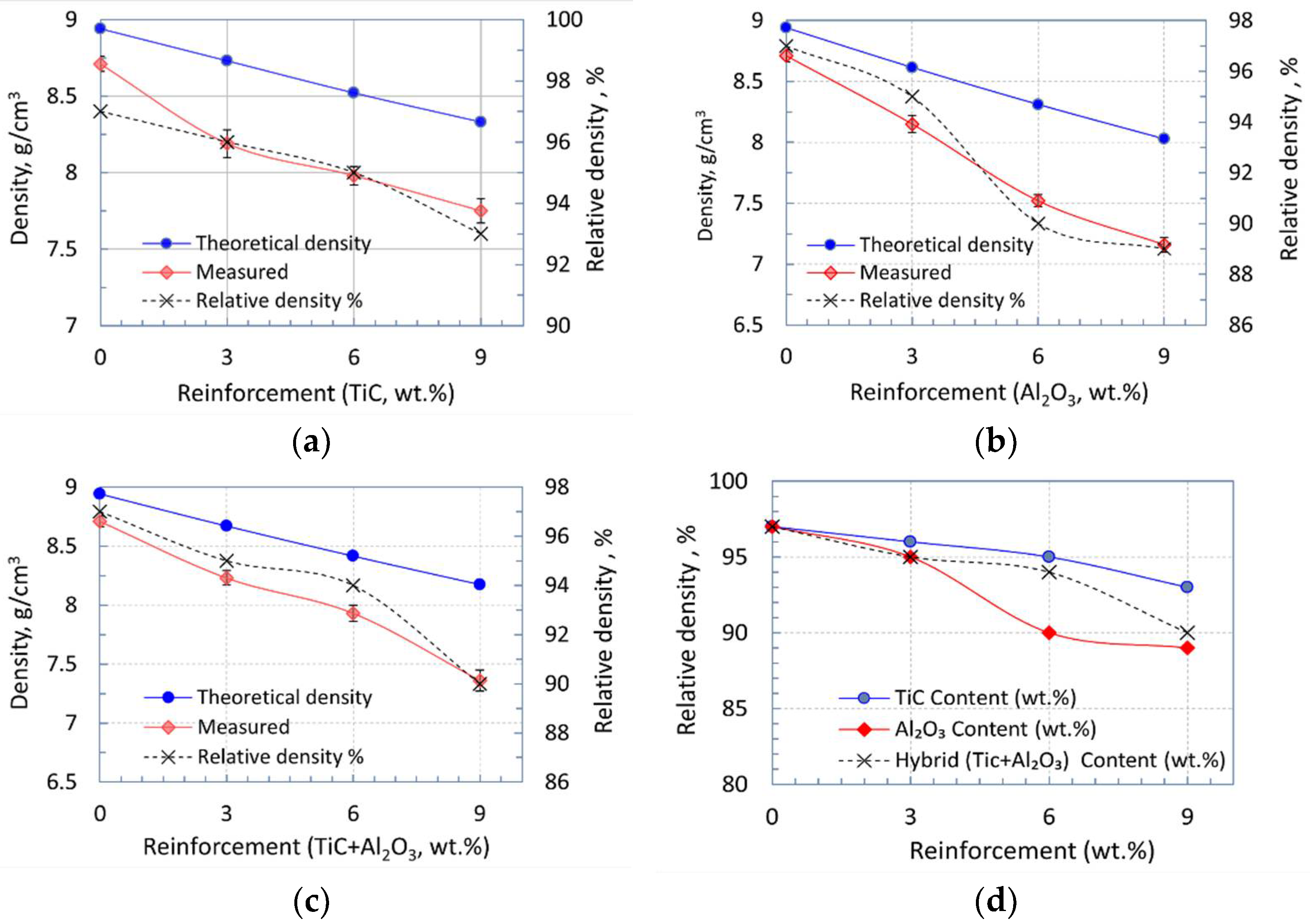



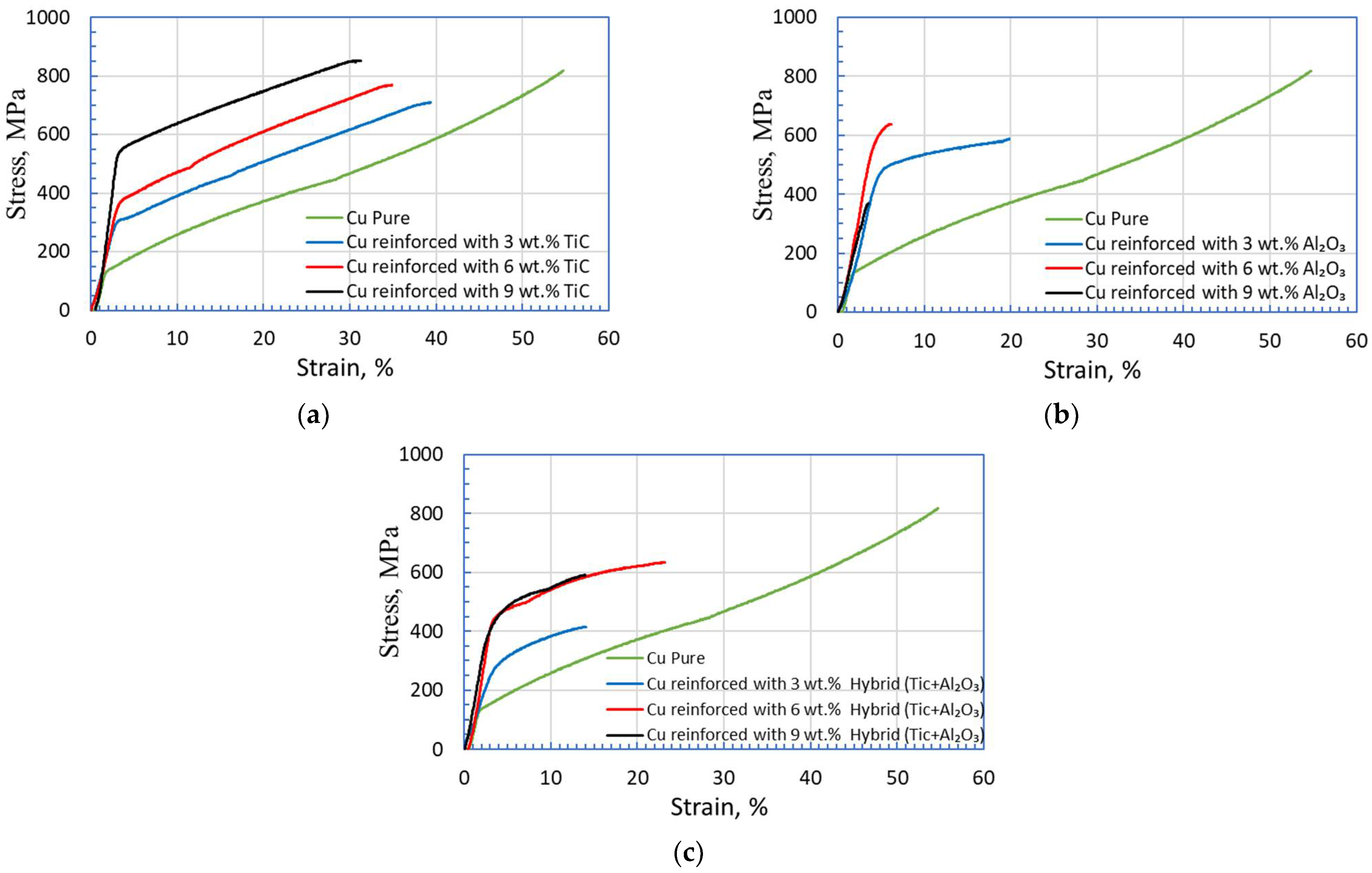
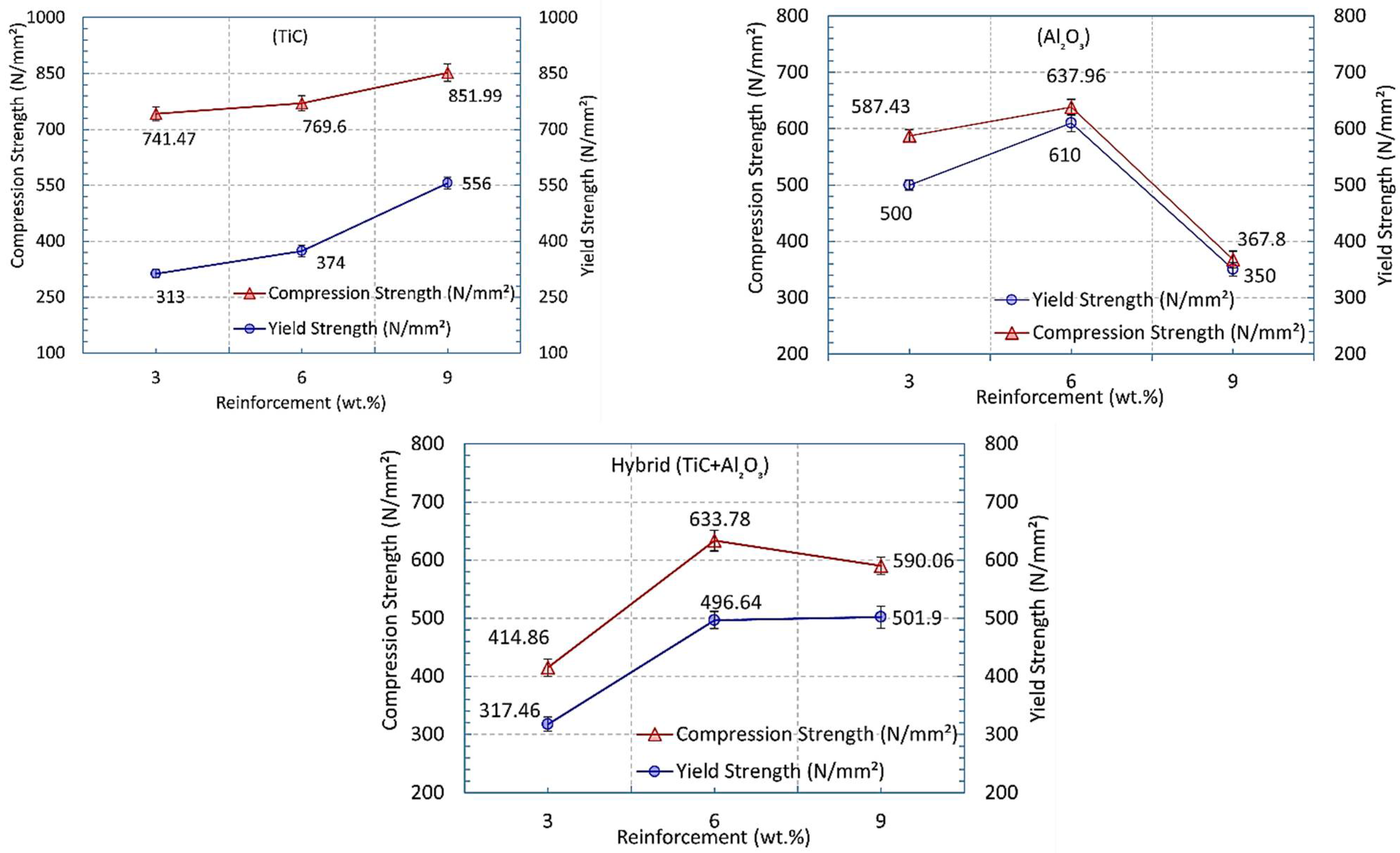
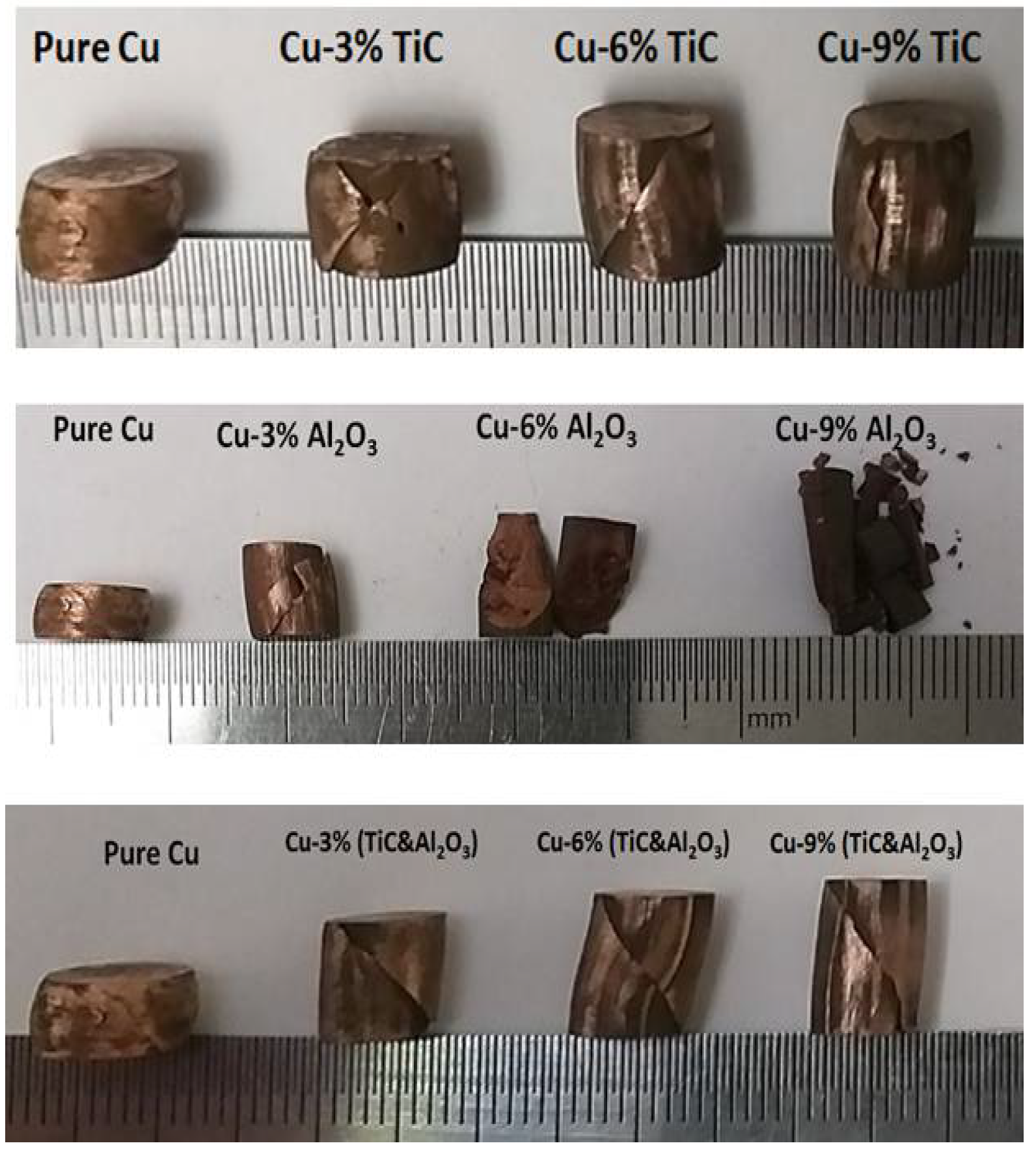
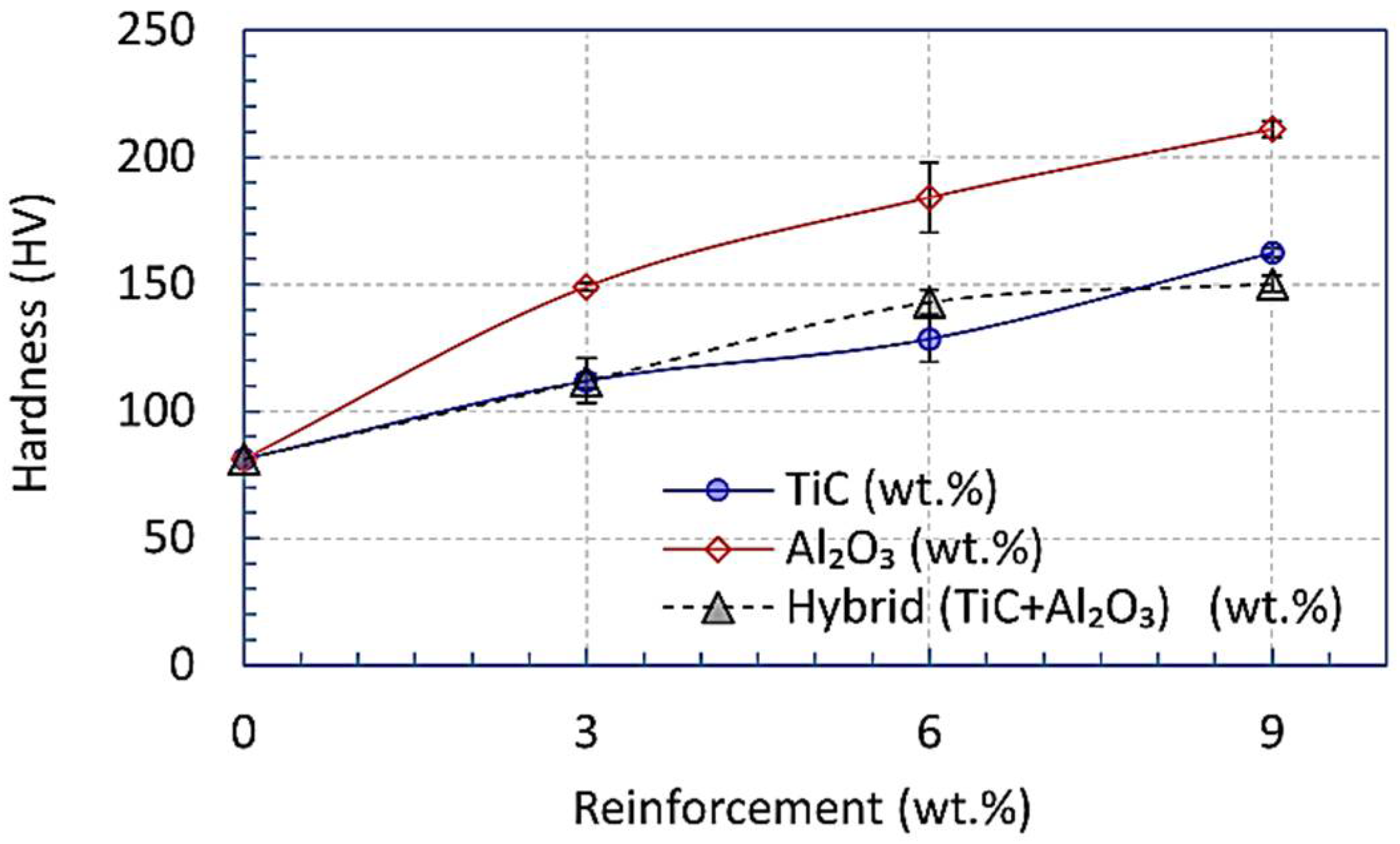
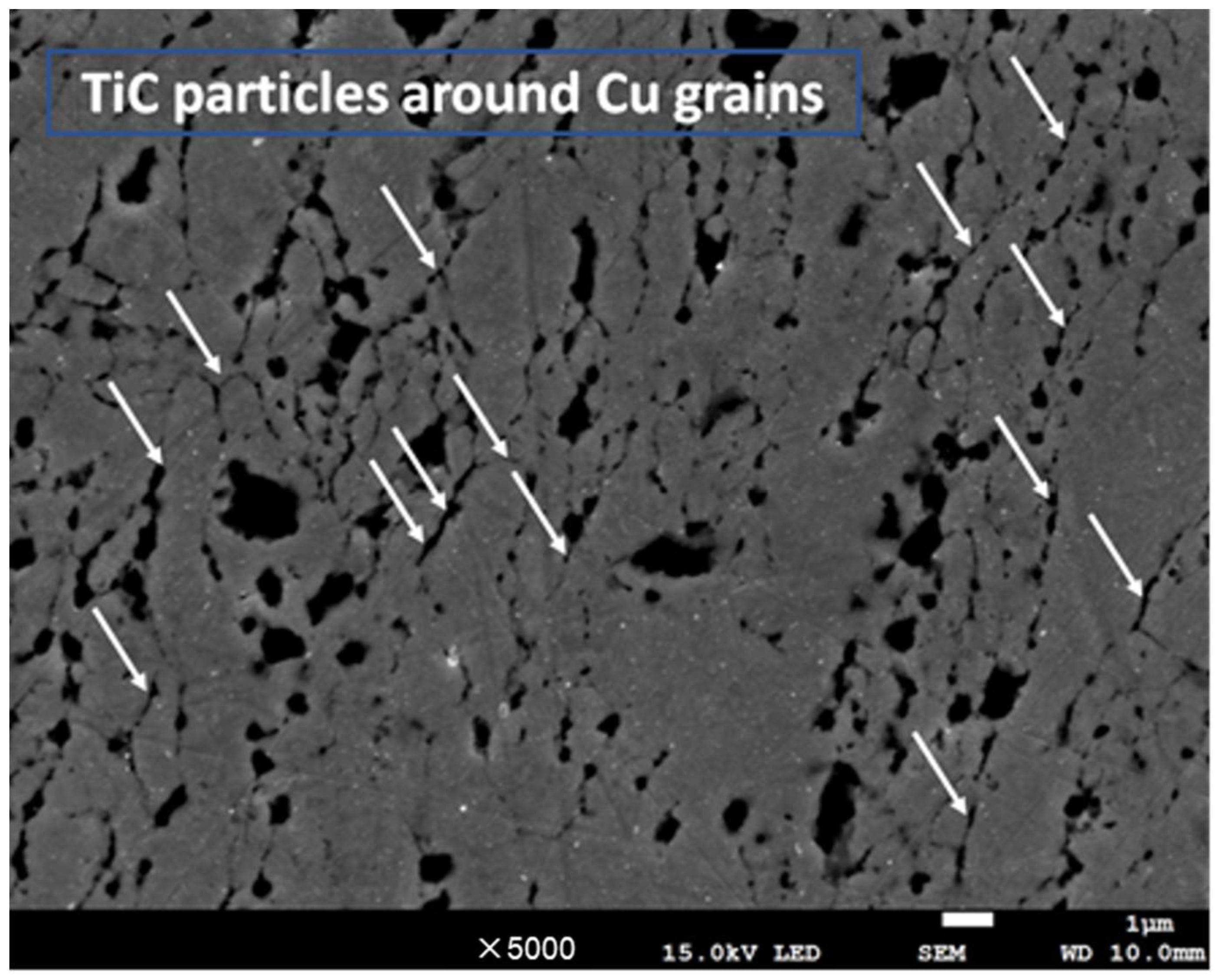
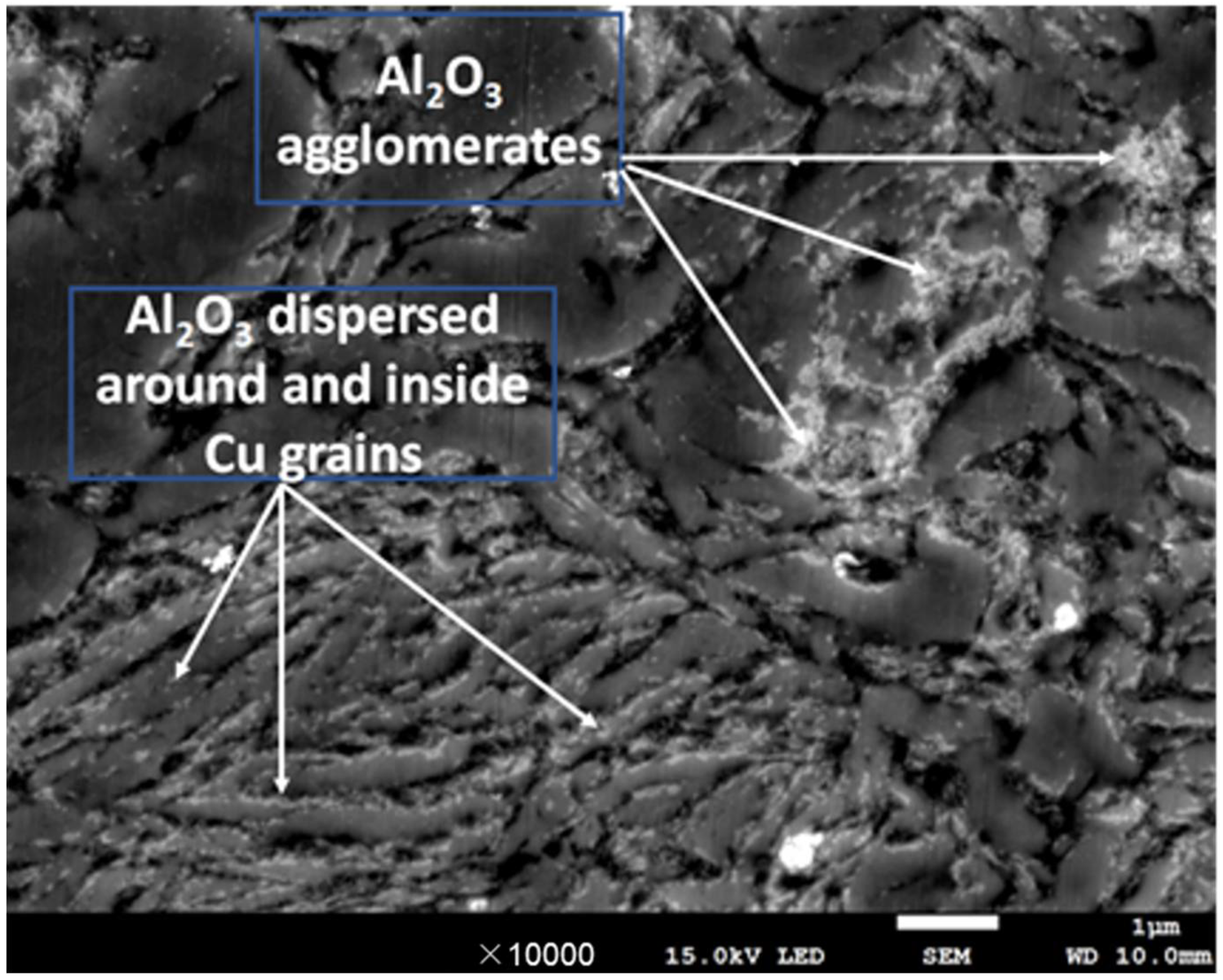
| Materials after Sintering by (SPS) | Composition | |||
|---|---|---|---|---|
| Matrix | Reinforcement | |||
| Cu [wt.%] | TiC [wt.%] | Al2O3 [wt.%] | ||
| 0 | Pure copper | 100 | ------- | ------- |
| I | Cu-3 wt.% TiC | 97 | 3 | ------- |
| Cu-6 wt.% TiC | 94 | 6 | ------- | |
| Cu-9 wt.% TiC | 91 | 9 | ------- | |
| II | Cu-3 wt.% Al2O3 | 97 | ------- | 3 |
| Cu-6 wt.% Al2O3 | 94 | ------- | 6 | |
| Cu-9 wt.% Al2O3 | 91 | ------- | 9 | |
| III | Cu-1.5 wt.% TiC and 1.5 wt.% Al2O3 | 97 | 1.5 | 1.5 |
| Cu-3 wt.% TiC and 3 wt.% Al2O3 | 94 | 3 | 3 | |
| Cu-4.5 wt.% TiC and 4.5 wt.% Al2O3 | 91 | 4.5 | 4.5 | |
| Composite | Method | Density, (g/cm3) | Ultimate Stress, (MPa) | Yield Stress, (MPa) | Elongation, (%) | Hardness, (HV) | Ref. No |
|---|---|---|---|---|---|---|---|
| Pure copper | SPS at 950 °C | 97 | N/A | 127.15 | 1.69 | 81 | [Present study] |
| Cu-3 wt.% TiC | 96 | 741.47 | 313 | 3.97 | 111.9 | ||
| Cu-3 wt.% Al2O3 | 95 | 587.43 | 500 | 6.17 | 149 | ||
| Cu-1.5 wt.% TiC and 1.5 wt.% Al2O3 | 95 | 414.86 | 317.46 | 5.25 | 112 | ||
| Cu-5 wt.% TiC | Hot Press at 700 °C | 93.3 | N/A | N/A | N/A | 67.3 | [50] |
| Cu-5 vol.%TiC | Hot extrusion | N/A | N/A | N/A | N/A | 112 | [51] |
| Cu-5 vol.% TiC | SPS | N/A | 712 | 661 | N/A | 221 | [14] |
| Cu-77 vol.% TiC | Sintering in Vacuum Furnace at 900 °C | 93.4 | N/A | N/A | N/A | 544 | [52] |
| Cu-5.3 vol.%TiC | SPS | N/A | 602 | 572 | N/A | 194 | [53] |
| Cu-3 wt.% Al2O3 with Coating Ag | Sintered at 950 °C | 95.9 | N/A | N/A | N/A | 85 | [7] |
| Cu-10 vol.% Al2O3 | Sintered at 880 °C | 83.49 | N/A | N/A | N/A | 71 | [54] |
| Cu-3 vol.% Al2O3 | Sintered at 850 °C | 91.5 | 350 | N/A | 0.51 | 77 | [55] |
| Cu-5 vol.% Al2O3 | Sintered at 850 °C | 88 | 550 | N/A | 0.46 | 100 | |
| Cu-5 vol.% Al2O3 | Sintering H2 at 850 °C | 530 | 450 | 2.5 | 155 | [56] | |
| Cu-2.7 wt.% Al2O3 | Sintered at 950 °C | 92.53 | 460 | 350 | N/A | 54.83 | [57] |
| Cu-5 vol.% Al2O3 | Conventional Sintering N₂ | 84.3 | N/A | N/A | N/A | 49 | [58] |
| Cu-5 vol.% Al2O3 | Conventional Sintering Ar | 84.3 | N/A | N/A | N/A | 48 | |
| Cu-5 vol.% Al2O3 | Conventional Sintering H₂ | 94.4 | N/A | N/A | N/A | 79 | |
| Cu-5 vol.% Al2O3 | SPS at 700 °C | 92.2 | N/A | N/A | N/A | 125 | |
| Cu-2.75 wt.% Al2O3 | Pulsed Electric Current Sintered (PECS) | 99.6 | N/A | N/A | N/A | 94.83 | [59] |
Publisher’s Note: MDPI stays neutral with regard to jurisdictional claims in published maps and institutional affiliations. |
© 2021 by the authors. Licensee MDPI, Basel, Switzerland. This article is an open access article distributed under the terms and conditions of the Creative Commons Attribution (CC BY) license (https://creativecommons.org/licenses/by/4.0/).
Share and Cite
Hamid, F.S.; A. Elkady, O.; Essa, A.R.S.; El-Nikhaily, A.; Elsayed, A.; Eessaa, A.K. Analysis of Microstructure and Mechanical Properties of Bi-Modal Nanoparticle-Reinforced Cu-Matrix. Crystals 2021, 11, 1081. https://doi.org/10.3390/cryst11091081
Hamid FS, A. Elkady O, Essa ARS, El-Nikhaily A, Elsayed A, Eessaa AK. Analysis of Microstructure and Mechanical Properties of Bi-Modal Nanoparticle-Reinforced Cu-Matrix. Crystals. 2021; 11(9):1081. https://doi.org/10.3390/cryst11091081
Chicago/Turabian StyleHamid, Fadel S., Omayma A. Elkady, A. R. S. Essa, A. El-Nikhaily, Ayman Elsayed, and Ashraf K. Eessaa. 2021. "Analysis of Microstructure and Mechanical Properties of Bi-Modal Nanoparticle-Reinforced Cu-Matrix" Crystals 11, no. 9: 1081. https://doi.org/10.3390/cryst11091081
APA StyleHamid, F. S., A. Elkady, O., Essa, A. R. S., El-Nikhaily, A., Elsayed, A., & Eessaa, A. K. (2021). Analysis of Microstructure and Mechanical Properties of Bi-Modal Nanoparticle-Reinforced Cu-Matrix. Crystals, 11(9), 1081. https://doi.org/10.3390/cryst11091081







